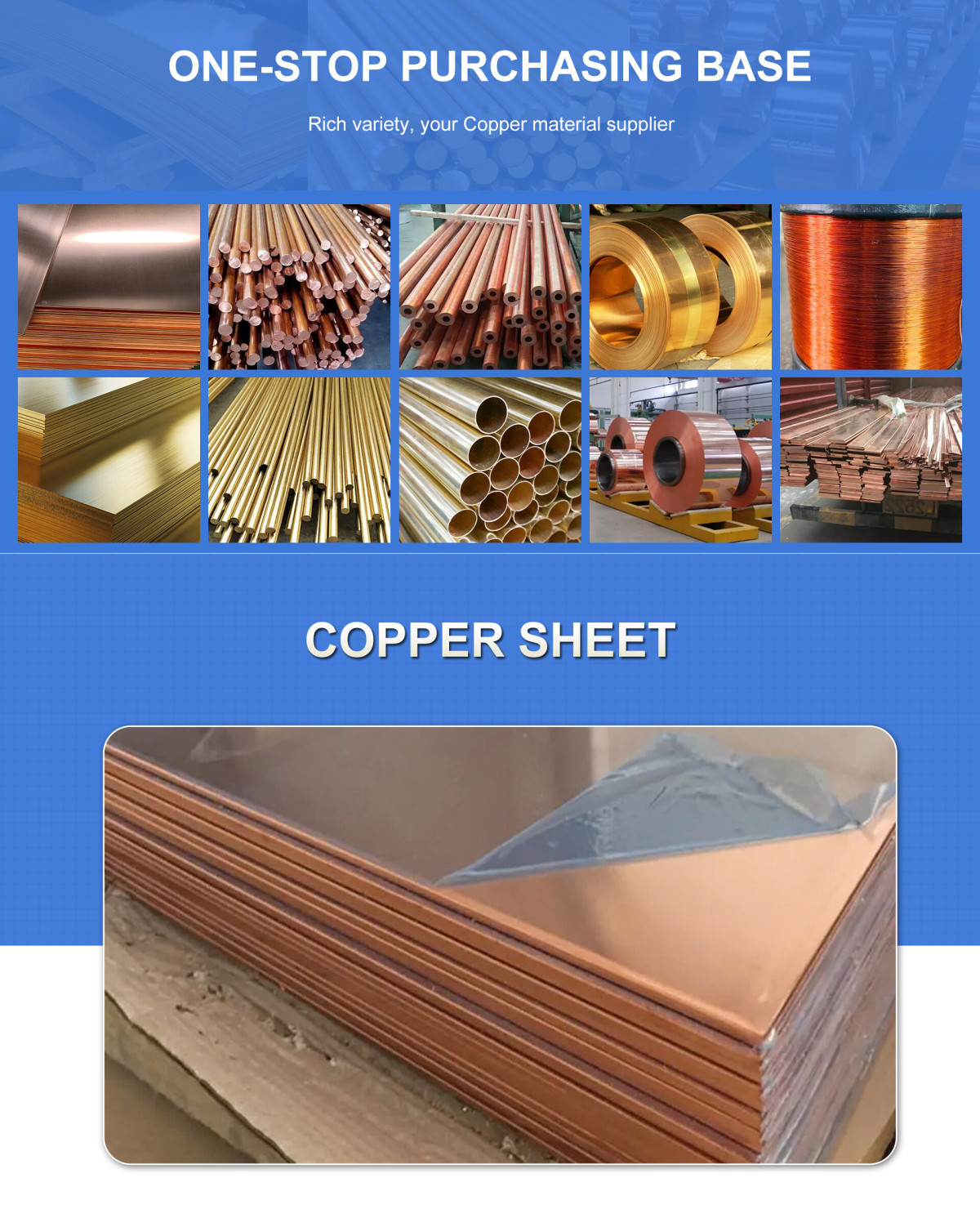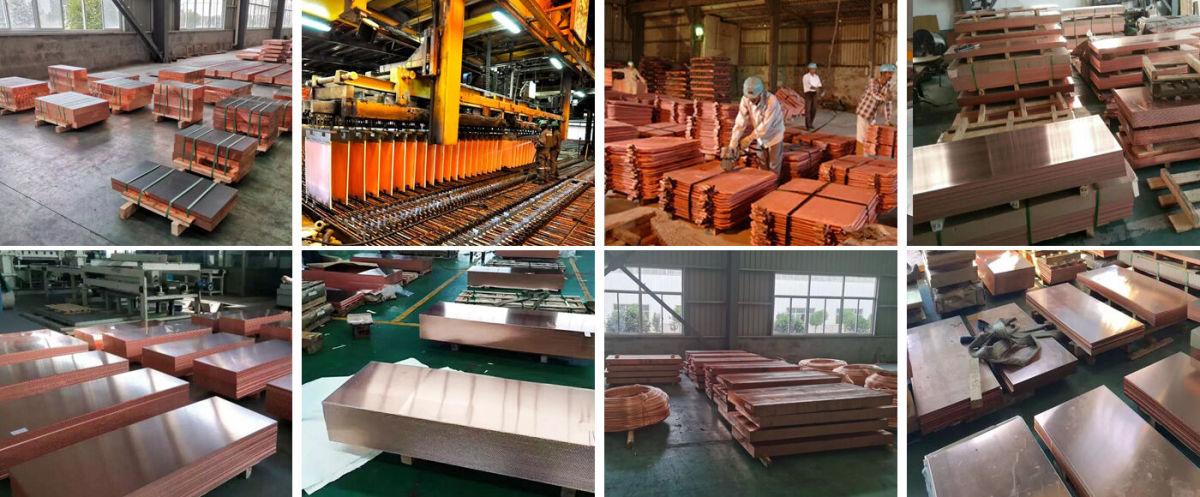
Thickness range:
Copper plate: The thickness range is relatively wide, with cold-rolled plates commonly ranging from 0.5–16.0 mm and hot-rolled plates ranging from 80–105 mm (but extra-thick plates are mostly used for special purposes).
Width range:
The width of the copper plate is determined by demand, with the maximum width of the cold-rolled plate being 1000 mm (some standards allow negotiation up to 1250 mm).
International Standards
European Standards:
EN 13599: Copper plates, sheets and strips for electrical purposes, 0.05–25 mm thick and 10–1250 mm wide, covering chemical composition, electrical conductivity (≥58 MS/m) and mechanical properties.
EN 1652: General copper plate and strip standard for non-electrical applications.
US Standards:
ASTM B248: Covers dimensional tolerances and mechanical properties of copper plates, used in conjunction with ASTM B152.
Chinese Standards:
GB/T 5231-2022: Specifies the chemical composition (Cu 79.0–81.0%, remainder Zn) and processing requirements of C24000.
Main ingredients:
Copper (Cu): 78.5%-81.5% (Chinese standard GB/T 5231-2012), US UNS C24000 standard is 76%-80%
Zinc (Zn): Balance, about 18%-23.5%.
Impurity control:
Lead (Pb): Chinese standard requires ≤0.03% or ≤0.05%, while UNS C24000 contains 0.5% Pb (low-lead brass).
Iron (Fe): ≤0.05%-0.10%.
Phosphorus (P): ≤0.01%.
The total of other impurities is ≤0.3%.
Mechanical properties
Strength and plasticity:
Tensile strength: 360 MPa (52,000 psi), some data show lower (235 MPa), which may be related to different processing conditions (such as annealed or cold-processed).
Yield strength: 170 MPa (25,000 psi).
Elongation: 42% (50 mm gauge length), the plasticity of Chinese standard H80 is good, suitable for hot and cold pressure processing.
Elastic modulus:
117 GPa (17,000 ksi)
Hardness:
Brinell hardness 82 HB, relatively low, but can be improved by cold hardening.

Production process and product advantages of C24000 copper plate:
1. Production process
Smelting and casting
C24000 brass is smelted in an industrial frequency cored induction furnace lined with silica sand. The volatilization of zinc at high temperature helps the melt to degas and deoxidize naturally. A small amount of phosphor copper is added before casting to improve fluidity. The casting temperature is 1100-1160℃.
Rolling and processing
Hot rolling: The ingot after melting and casting is milled and hot rolled after heating to ensure the uniformity and initial shaping of the material.
Cold rolling and annealing: The plate after hot rolling enters the cold rolling stage, and then annealing (450-680℃) is used to eliminate internal stress, restore plasticity, and remove the surface oxide layer with pickling.
Finishing rolling and finishing: After multiple cold rolling and annealing, the plate enters the finishing rolling stage (intermediate rolling and fine rolling), and finally forms a finished product through leveling, shearing and other processes.
Surface treatment (optional)
Some products may be post-treated by washing, degreasing, painting (primer and topcoat) and drying to enhance corrosion resistance or aesthetics.
2. Product advantages
Excellent corrosion resistance
Performs well in the atmosphere, fresh water and seawater, with corrosion rates of 0.0001-0.00075 mm/a, 0.0025-0.025 mm/a and 0.0075-0.1 mm/a respectively.
However, it is sensitive to oxidizing acids, hydrated sulfides and stress corrosion, and needs to be annealed (200-300℃) to eliminate the stress after cold work hardening.
Excellent mechanical properties
Tensile strength covers 270-480 MPa (different heat treatment states), elongation can reach 38% (R270 state), hardness ranges from 55-155 HV, suitable for scenes with high strength and ductility requirements.
Carrying large current and high voltage, high temperature resistance (above 90℃) and pressure resistance (4000V without breakdown), it is suitable for industrial control, military industry and other fields.
Good processing performance
Excellent cold forming performance (the deformation between two annealings can reach 90%), and good hot forming performance (750-870℃).
It can be welded (excellent brazing and soldering performance), stamped, engraved and other processing, with high surface finish.
Wide range of application fields
Mainly used for instrument housing, waveguide, corrosion-resistant conduit, metal filter, as well as papermaking net, thin-walled tube, and building supplies.
It also has important applications in decoration (such as coinage, jewelry), electronic components, and musical instrument manufacturing.
Q1:Do you provide samples? Is it free or extra?
A1:Yes, we can provide samples free of charge and the customer will pay the freight.
Q2:What if I don't have export experience ?
A2:We have reliable forwarder agent which can ship items to you by sea/air/Express to your doorstep. Any way, we will help you choose the most suitable shipping service.
Q3:How long is your lead time?
A3:If it is in stock, it is usually 5-10 days. Or, if there is no inventory, 15 days, depending on the quantity.
Q4:What are your terms of payment?
A4:30% T/T deposit in advance, 70% T/T balance within 5 days after B/L copy, 100%.Irrevocable L/C at sight, 100% Irrevocable L/C after receive B/L 30-120 days, O/A.
Q5:How is your technical support?
A5:We provide lifetime online support through Whatsapp/ Skype/ Wechat/ Email. Any problem after delivery, we will offer you call anytime.
Welcome To Your Inquiry
What can we help you?
RELATED PRODUCTS








